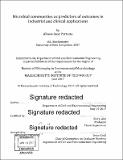| dc.contributor.advisor | Eric J. Alm. | en_US |
| dc.contributor.author | Perrotta, Allison Rose | en_US |
| dc.contributor.other | Massachusetts Institute of Technology. Department of Civil and Environmental Engineering. | en_US |
| dc.date.accessioned | 2017-09-15T15:34:34Z | |
| dc.date.available | 2017-09-15T15:34:34Z | |
| dc.date.copyright | 2017 | en_US |
| dc.date.issued | 2017 | en_US |
| dc.identifier.uri | http://hdl.handle.net/1721.1/111446 | |
| dc.description | Thesis: Ph. D. in Environmental Microbiology, Massachusetts Institute of Technology, Department of Civil and Environmental Engineering, 2017. | en_US |
| dc.description | Cataloged from PDF version of thesis. | en_US |
| dc.description | Includes bibliographical references. | en_US |
| dc.description.abstract | Environmental and host associated microbial communities provide an extensive reservoir of genetic and functional diversity. This diversity represents a wealth of potential for applications in many fields. To harness this potential for engineering applications, the impact of temporal dynamics need to be better understood. Yet most of the data we have are in the form of static surveys of diversity. In this thesis, I use 16S rRNA sequencing analysis to measure community composition across time series to predict outcomes for three applications: bioreactor function; a non-invasive diagnostic of endometriosis; and commercial chicken rearing. I identify bacteria that exhibit distinct temporal dynamics within each application, and discuss the implications of those dynamics in the context of each application. Despite the diverse communities covered in this work, temporal dynamics emerge as a common theme that can impact these engineering applications which rely on stable and predictable community performance. | en_US |
| dc.description.statementofresponsibility | by Allison Rose Perrotta. | en_US |
| dc.format.extent | 108 pages | en_US |
| dc.language.iso | eng | en_US |
| dc.publisher | Massachusetts Institute of Technology | en_US |
| dc.rights | MIT theses are protected by copyright. They may be viewed, downloaded, or printed from this source but further reproduction or distribution in any format is prohibited without written permission. | en_US |
| dc.rights.uri | http://dspace.mit.edu/handle/1721.1/7582 | en_US |
| dc.subject | Civil and Environmental Engineering. | en_US |
| dc.title | Microbial communities as predictors of outcomes in industrial and clinical applications | en_US |
| dc.type | Thesis | en_US |
| dc.description.degree | Ph. D. in Environmental Microbiology | en_US |
| dc.contributor.department | Massachusetts Institute of Technology. Department of Civil and Environmental Engineering | |
| dc.identifier.oclc | 1003292884 | en_US |

